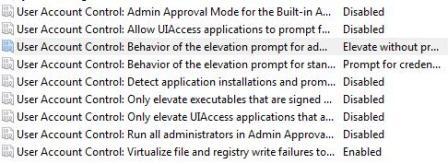The user interface of User Account Control (UAC) settings in Windows 7 has changed to reflect the move to make UAC less annoying, more user control and more user friendlier approach. In Windows 7, the UAC has a slider bar which allows users to configure and select which level of notification (and hence protection against unauthorized and malicious access) they want. With the fine-tuning of UAC, the wording 'disable' or 'turn off' is no longer available. So how can you disable UAC? Or at least, how can you turn off the notification prompt or pop-up so that they appear less regularly?
In fact, the steps to disable UAC is Windows 7 is similar to steps to disable UAC in Windows Vista, only with slight user interface change, and there is plenty of methods to turn off UAC too.
Method 1: Disable or Turn Off UAC (User Account Control) in Control Panel
- To user Control Panel to disable UAC in Windows 7, there are several methods to access the User Account Control settings page:
- Go to Start Menu -> Control Panel -> User Accounts and Family Safety -> User Account.
- Go to Start Menu -> Control Panel -> System and Security -> Action Center.
- Click or right click on Flag icon in notification area (system tray), and then Open Action Center.
- Type "MsConfig" in Start Search to start System Configuration, then go to Tools tab, select Change UAC Settings, then click on Launch button.
- Click on User Account Control settings link.

- Slide the slider bar to the lowest value (towards Never Notify), with description showing Never notify me.

- Click OK to make the change effective.
- Restart the computer to turn off User Access Control.
Method 2: Disable UAC with Registry Editor (RegEdit)
- Run Registry Editor (RegEdit).
- Navigate to the following registry key:
HKEY_LOCAL_MACHINE\Software\Microsoft\Windows\CurrentVersion\Policies\System
- Locate the following REG_DWORD value:
EnableLUA
- Set the value of EnableLUA to 0.
- Optional step to suppress UAC consent prompt dialog, locate the following REG_DWORD value:
ConsentPromptBehaviorAdmin
- Set the value of ConsentPromptBehaviorAdmin to 0 (optional).
- Exit from Registry Editor and restart the computer to turn off UAC.
Method 3: Turn Off UAC Using Group Policy
For Windows 7 Ultimate, Business or Enterprise edition which has Local Group Policy, or computer joined to domain and has Active Directory-based GPO, the group policy can be used to disable UAC for local computer or many computer across large networks at once.
- Enter GPedit.msc in Start Search to run Local Group Policy editor. (Or gpmc.msc to run Group Policy Management Console for AD-based domain GPO editor).
- Navigate to the following tree branch:
Computer Configuration -> Windows Settings -> Security Settings -> Local Policies -> Security Options
In GPMC, browse to the required GPO which is linked to the domain or OU where the policy wants to apply.
- Locate the following policy in the right pane:
User Account Control: Behavior of the elevation prompt for administrators in Admin Approval Mode
Set its value to Elevate without prompt.
- Locate the following policy in the right pane:
User Account Control: Detect application installations and prompt for elevation
Set its value to Disabled.
- Locate the following policy in the right pane:
User Account Control: Run all administrators in Admin Approval Mode
Set its value to Disabled.
- Locate the following policy in the right pane:
User Account Control: Only elevate UIAccess applications that are installed in secure locations
Set its value to Disabled.

Restart the computer when done.
Method 4: Using Command Prompt to Disable User Account Control
The command line option can also be used in batch script command file, i.e. .bat and .cmd files, providing greater convenient to advanced technical user. In actual, the commands,, which are also used to disable or enable UAC in Vista, are just doing the same thing as directly modifying the registry.
- Open an elevated command prompt as administrator.
- To disable the UAC, run the following commands:
%windir%\System32\cmd.exe /k %windir%\System32\reg.exe ADD HKEY_LOCAL_MACHINE\SOFTWARE\Microsoft\Windows\CurrentVersion\Policies\System /v EnableLUA /t REG_DWORD /d 0 /f
and optionally, the following comand to suppress all elevation consent request and notification:
%windir%\System32\cmd.exe /k %windir%\System32\reg.exe ADD HKEY_LOCAL_MACHINE\SOFTWARE\Microsoft\Windows\CurrentVersion\Policies\System /v ConsentPromptBehaviorAdmin /t REG_DWORD /d 0 /f
Tip: To re-enable UAC, the command is:
%windir%\System32\cmd.exe /k %windir%\System32\reg.exe ADD HKEY_LOCAL_MACHINE\SOFTWARE\Microsoft\Windows\CurrentVersion\Policies\System /v EnableLUA /t REG_DWORD /d 1 /f
and to turn on prompt for consent UI:
%windir%\System32\cmd.exe /k %windir%\System32\reg.exe ADD HKEY_LOCAL_MACHINE\SOFTWARE\Microsoft\Windows\CurrentVersion\Policies\System /v ConsentPromptBehaviorAdmin /t REG_DWORD /d 2 /f
Disable UAC may cause gadget not working in Windows 7. User who facing the issue can use another workaround to suppress User Account Control.






Post a Comment